Earthwork Equipment And Technique
VerifiedAdded on 2022/08/12
|16
|3594
|23
AI Summary
I need two differents copies of the assignment (plagiarism free two different writers )
Contribute Materials
Your contribution can guide someone’s learning journey. Share your
documents today.
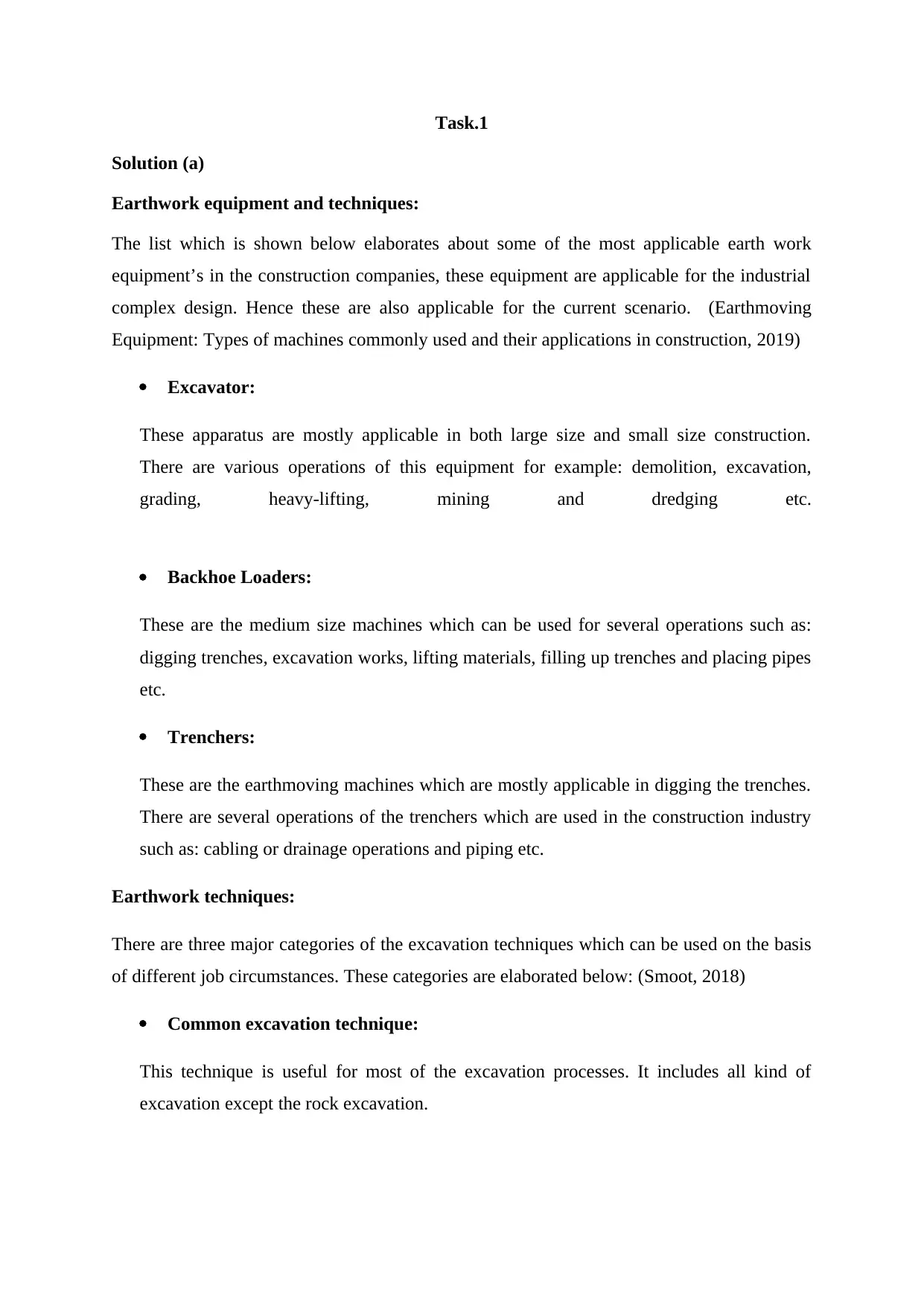
Task.1
Solution (a)
Earthwork equipment and techniques:
The list which is shown below elaborates about some of the most applicable earth work
equipment’s in the construction companies, these equipment are applicable for the industrial
complex design. Hence these are also applicable for the current scenario. (Earthmoving
Equipment: Types of machines commonly used and their applications in construction, 2019)
Excavator:
These apparatus are mostly applicable in both large size and small size construction.
There are various operations of this equipment for example: demolition, excavation,
grading, heavy-lifting, mining and dredging etc.
Backhoe Loaders:
These are the medium size machines which can be used for several operations such as:
digging trenches, excavation works, lifting materials, filling up trenches and placing pipes
etc.
Trenchers:
These are the earthmoving machines which are mostly applicable in digging the trenches.
There are several operations of the trenchers which are used in the construction industry
such as: cabling or drainage operations and piping etc.
Earthwork techniques:
There are three major categories of the excavation techniques which can be used on the basis
of different job circumstances. These categories are elaborated below: (Smoot, 2018)
Common excavation technique:
This technique is useful for most of the excavation processes. It includes all kind of
excavation except the rock excavation.
Solution (a)
Earthwork equipment and techniques:
The list which is shown below elaborates about some of the most applicable earth work
equipment’s in the construction companies, these equipment are applicable for the industrial
complex design. Hence these are also applicable for the current scenario. (Earthmoving
Equipment: Types of machines commonly used and their applications in construction, 2019)
Excavator:
These apparatus are mostly applicable in both large size and small size construction.
There are various operations of this equipment for example: demolition, excavation,
grading, heavy-lifting, mining and dredging etc.
Backhoe Loaders:
These are the medium size machines which can be used for several operations such as:
digging trenches, excavation works, lifting materials, filling up trenches and placing pipes
etc.
Trenchers:
These are the earthmoving machines which are mostly applicable in digging the trenches.
There are several operations of the trenchers which are used in the construction industry
such as: cabling or drainage operations and piping etc.
Earthwork techniques:
There are three major categories of the excavation techniques which can be used on the basis
of different job circumstances. These categories are elaborated below: (Smoot, 2018)
Common excavation technique:
This technique is useful for most of the excavation processes. It includes all kind of
excavation except the rock excavation.
Secure Best Marks with AI Grader
Need help grading? Try our AI Grader for instant feedback on your assignments.
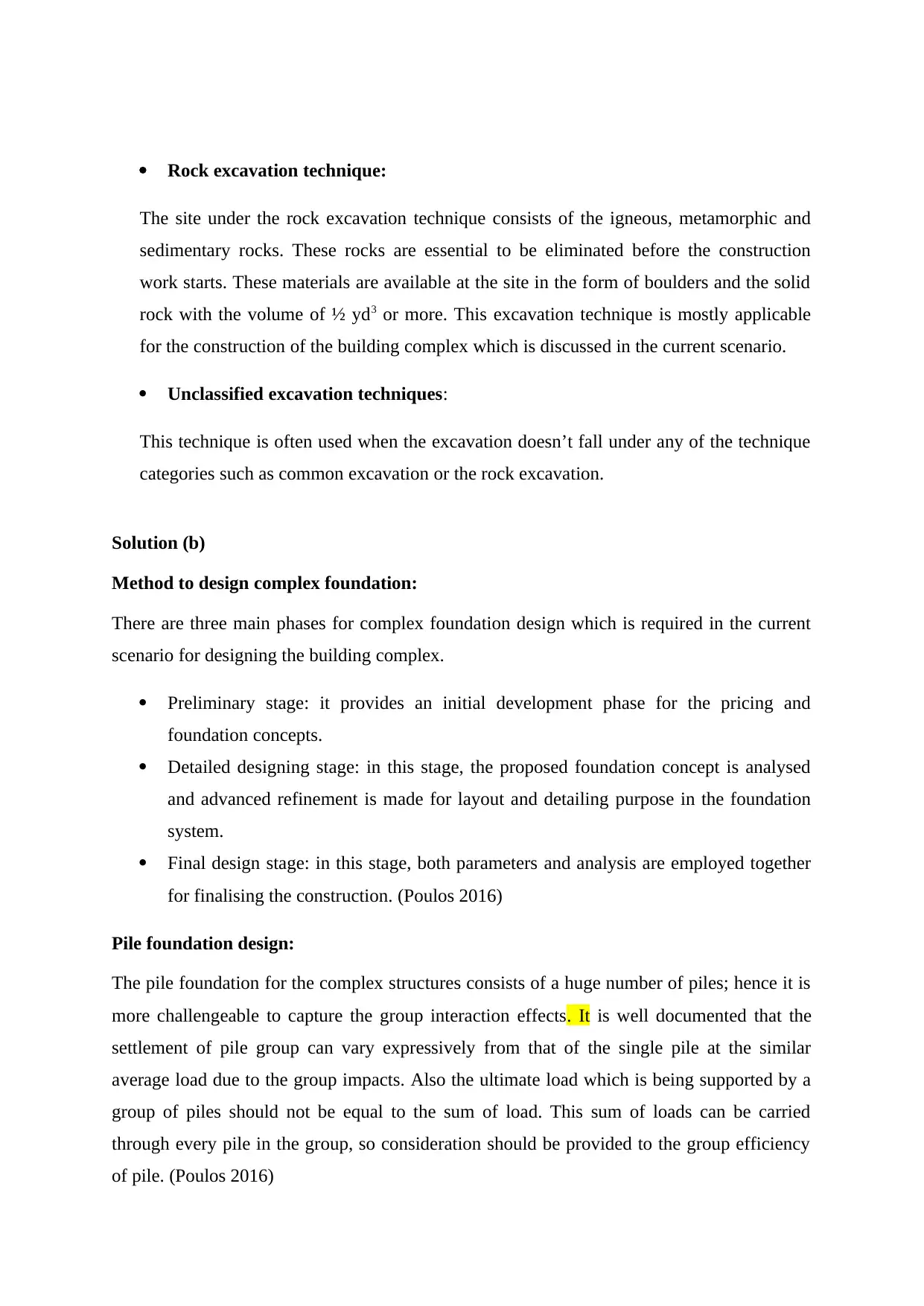
Rock excavation technique:
The site under the rock excavation technique consists of the igneous, metamorphic and
sedimentary rocks. These rocks are essential to be eliminated before the construction
work starts. These materials are available at the site in the form of boulders and the solid
rock with the volume of ½ yd3 or more. This excavation technique is mostly applicable
for the construction of the building complex which is discussed in the current scenario.
Unclassified excavation techniques:
This technique is often used when the excavation doesn’t fall under any of the technique
categories such as common excavation or the rock excavation.
Solution (b)
Method to design complex foundation:
There are three main phases for complex foundation design which is required in the current
scenario for designing the building complex.
Preliminary stage: it provides an initial development phase for the pricing and
foundation concepts.
Detailed designing stage: in this stage, the proposed foundation concept is analysed
and advanced refinement is made for layout and detailing purpose in the foundation
system.
Final design stage: in this stage, both parameters and analysis are employed together
for finalising the construction. (Poulos 2016)
Pile foundation design:
The pile foundation for the complex structures consists of a huge number of piles; hence it is
more challengeable to capture the group interaction effects. It is well documented that the
settlement of pile group can vary expressively from that of the single pile at the similar
average load due to the group impacts. Also the ultimate load which is being supported by a
group of piles should not be equal to the sum of load. This sum of loads can be carried
through every pile in the group, so consideration should be provided to the group efficiency
of pile. (Poulos 2016)
The site under the rock excavation technique consists of the igneous, metamorphic and
sedimentary rocks. These rocks are essential to be eliminated before the construction
work starts. These materials are available at the site in the form of boulders and the solid
rock with the volume of ½ yd3 or more. This excavation technique is mostly applicable
for the construction of the building complex which is discussed in the current scenario.
Unclassified excavation techniques:
This technique is often used when the excavation doesn’t fall under any of the technique
categories such as common excavation or the rock excavation.
Solution (b)
Method to design complex foundation:
There are three main phases for complex foundation design which is required in the current
scenario for designing the building complex.
Preliminary stage: it provides an initial development phase for the pricing and
foundation concepts.
Detailed designing stage: in this stage, the proposed foundation concept is analysed
and advanced refinement is made for layout and detailing purpose in the foundation
system.
Final design stage: in this stage, both parameters and analysis are employed together
for finalising the construction. (Poulos 2016)
Pile foundation design:
The pile foundation for the complex structures consists of a huge number of piles; hence it is
more challengeable to capture the group interaction effects. It is well documented that the
settlement of pile group can vary expressively from that of the single pile at the similar
average load due to the group impacts. Also the ultimate load which is being supported by a
group of piles should not be equal to the sum of load. This sum of loads can be carried
through every pile in the group, so consideration should be provided to the group efficiency
of pile. (Poulos 2016)
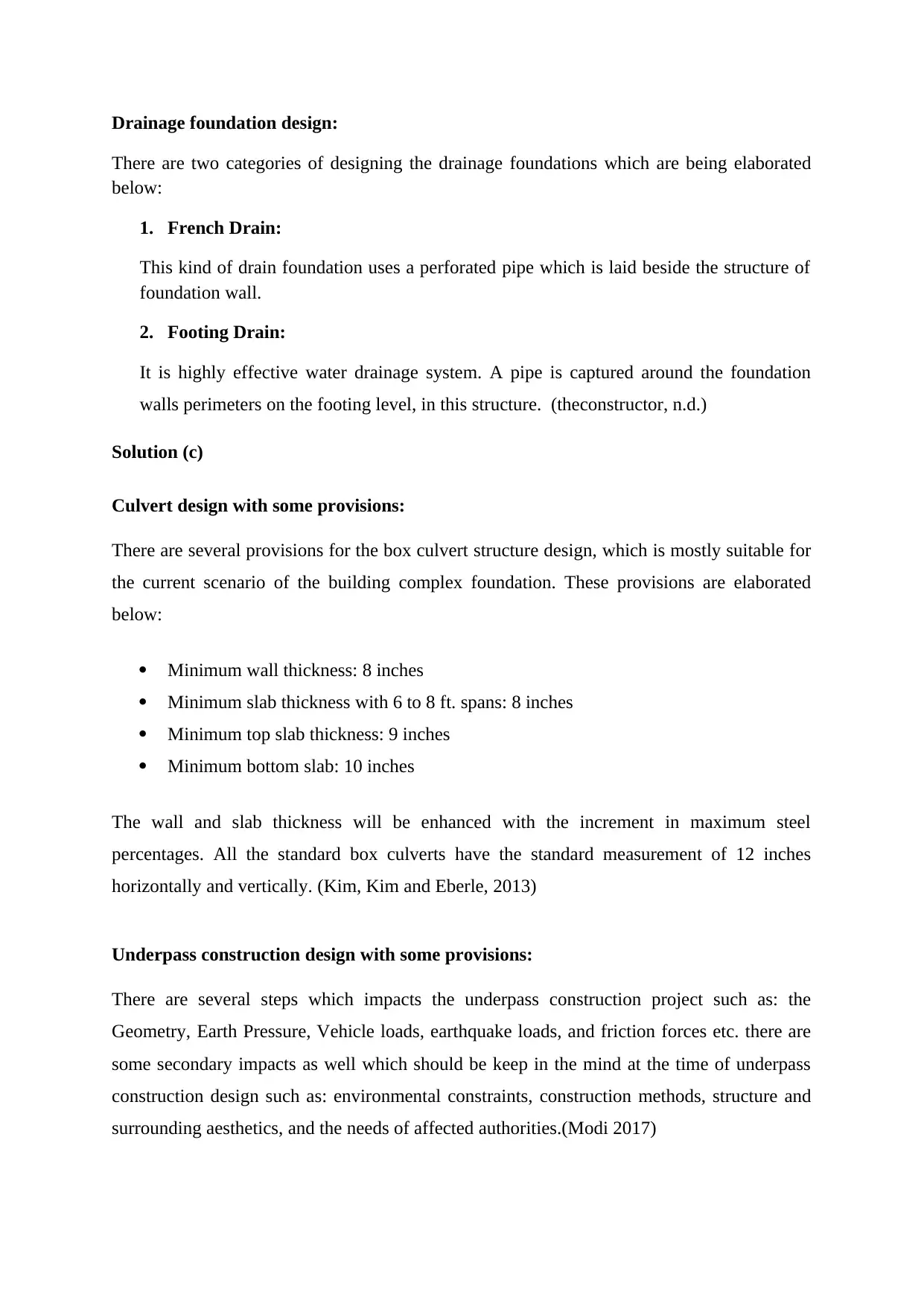
Drainage foundation design:
There are two categories of designing the drainage foundations which are being elaborated
below:
1. French Drain:
This kind of drain foundation uses a perforated pipe which is laid beside the structure of
foundation wall.
2. Footing Drain:
It is highly effective water drainage system. A pipe is captured around the foundation
walls perimeters on the footing level, in this structure. (theconstructor, n.d.)
Solution (c)
Culvert design with some provisions:
There are several provisions for the box culvert structure design, which is mostly suitable for
the current scenario of the building complex foundation. These provisions are elaborated
below:
Minimum wall thickness: 8 inches
Minimum slab thickness with 6 to 8 ft. spans: 8 inches
Minimum top slab thickness: 9 inches
Minimum bottom slab: 10 inches
The wall and slab thickness will be enhanced with the increment in maximum steel
percentages. All the standard box culverts have the standard measurement of 12 inches
horizontally and vertically. (Kim, Kim and Eberle, 2013)
Underpass construction design with some provisions:
There are several steps which impacts the underpass construction project such as: the
Geometry, Earth Pressure, Vehicle loads, earthquake loads, and friction forces etc. there are
some secondary impacts as well which should be keep in the mind at the time of underpass
construction design such as: environmental constraints, construction methods, structure and
surrounding aesthetics, and the needs of affected authorities.(Modi 2017)
There are two categories of designing the drainage foundations which are being elaborated
below:
1. French Drain:
This kind of drain foundation uses a perforated pipe which is laid beside the structure of
foundation wall.
2. Footing Drain:
It is highly effective water drainage system. A pipe is captured around the foundation
walls perimeters on the footing level, in this structure. (theconstructor, n.d.)
Solution (c)
Culvert design with some provisions:
There are several provisions for the box culvert structure design, which is mostly suitable for
the current scenario of the building complex foundation. These provisions are elaborated
below:
Minimum wall thickness: 8 inches
Minimum slab thickness with 6 to 8 ft. spans: 8 inches
Minimum top slab thickness: 9 inches
Minimum bottom slab: 10 inches
The wall and slab thickness will be enhanced with the increment in maximum steel
percentages. All the standard box culverts have the standard measurement of 12 inches
horizontally and vertically. (Kim, Kim and Eberle, 2013)
Underpass construction design with some provisions:
There are several steps which impacts the underpass construction project such as: the
Geometry, Earth Pressure, Vehicle loads, earthquake loads, and friction forces etc. there are
some secondary impacts as well which should be keep in the mind at the time of underpass
construction design such as: environmental constraints, construction methods, structure and
surrounding aesthetics, and the needs of affected authorities.(Modi 2017)
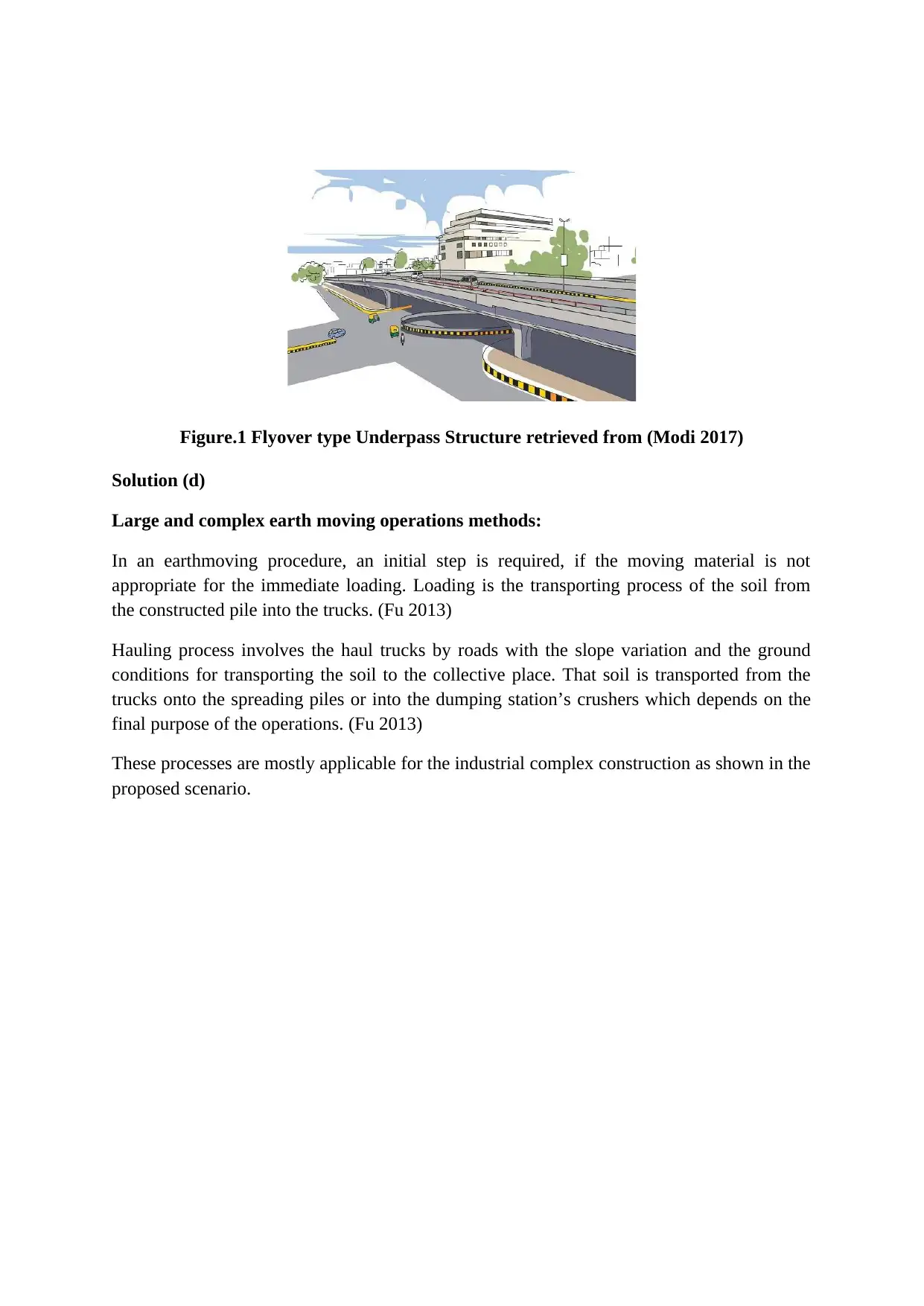
Figure.1 Flyover type Underpass Structure retrieved from (Modi 2017)
Solution (d)
Large and complex earth moving operations methods:
In an earthmoving procedure, an initial step is required, if the moving material is not
appropriate for the immediate loading. Loading is the transporting process of the soil from
the constructed pile into the trucks. (Fu 2013)
Hauling process involves the haul trucks by roads with the slope variation and the ground
conditions for transporting the soil to the collective place. That soil is transported from the
trucks onto the spreading piles or into the dumping station’s crushers which depends on the
final purpose of the operations. (Fu 2013)
These processes are mostly applicable for the industrial complex construction as shown in the
proposed scenario.
Solution (d)
Large and complex earth moving operations methods:
In an earthmoving procedure, an initial step is required, if the moving material is not
appropriate for the immediate loading. Loading is the transporting process of the soil from
the constructed pile into the trucks. (Fu 2013)
Hauling process involves the haul trucks by roads with the slope variation and the ground
conditions for transporting the soil to the collective place. That soil is transported from the
trucks onto the spreading piles or into the dumping station’s crushers which depends on the
final purpose of the operations. (Fu 2013)
These processes are mostly applicable for the industrial complex construction as shown in the
proposed scenario.
Secure Best Marks with AI Grader
Need help grading? Try our AI Grader for instant feedback on your assignments.
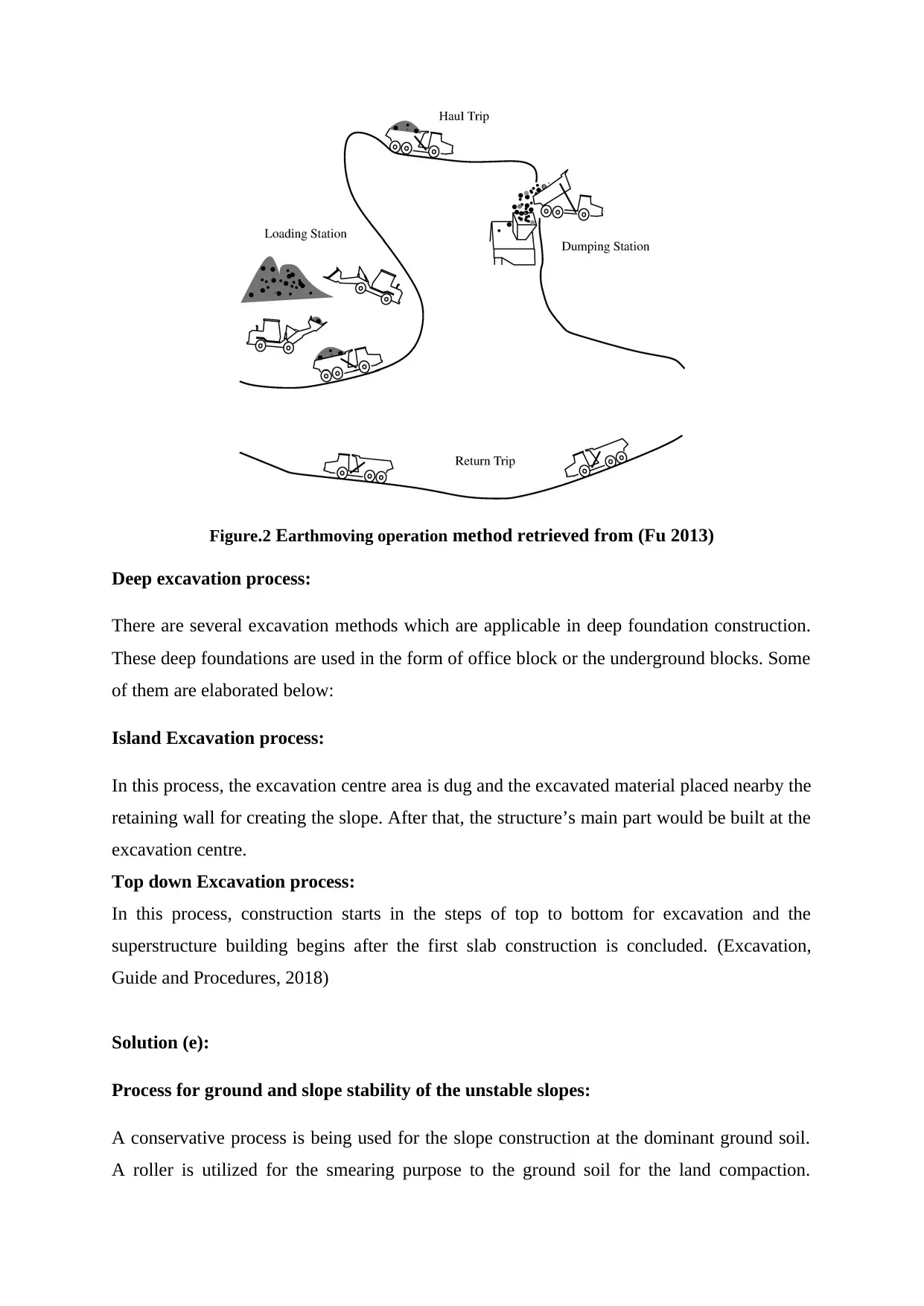
Figure.2 Earthmoving operation method retrieved from (Fu 2013)
Deep excavation process:
There are several excavation methods which are applicable in deep foundation construction.
These deep foundations are used in the form of office block or the underground blocks. Some
of them are elaborated below:
Island Excavation process:
In this process, the excavation centre area is dug and the excavated material placed nearby the
retaining wall for creating the slope. After that, the structure’s main part would be built at the
excavation centre.
Top down Excavation process:
In this process, construction starts in the steps of top to bottom for excavation and the
superstructure building begins after the first slab construction is concluded. (Excavation,
Guide and Procedures, 2018)
Solution (e):
Process for ground and slope stability of the unstable slopes:
A conservative process is being used for the slope construction at the dominant ground soil.
A roller is utilized for the smearing purpose to the ground soil for the land compaction.
Deep excavation process:
There are several excavation methods which are applicable in deep foundation construction.
These deep foundations are used in the form of office block or the underground blocks. Some
of them are elaborated below:
Island Excavation process:
In this process, the excavation centre area is dug and the excavated material placed nearby the
retaining wall for creating the slope. After that, the structure’s main part would be built at the
excavation centre.
Top down Excavation process:
In this process, construction starts in the steps of top to bottom for excavation and the
superstructure building begins after the first slab construction is concluded. (Excavation,
Guide and Procedures, 2018)
Solution (e):
Process for ground and slope stability of the unstable slopes:
A conservative process is being used for the slope construction at the dominant ground soil.
A roller is utilized for the smearing purpose to the ground soil for the land compaction.
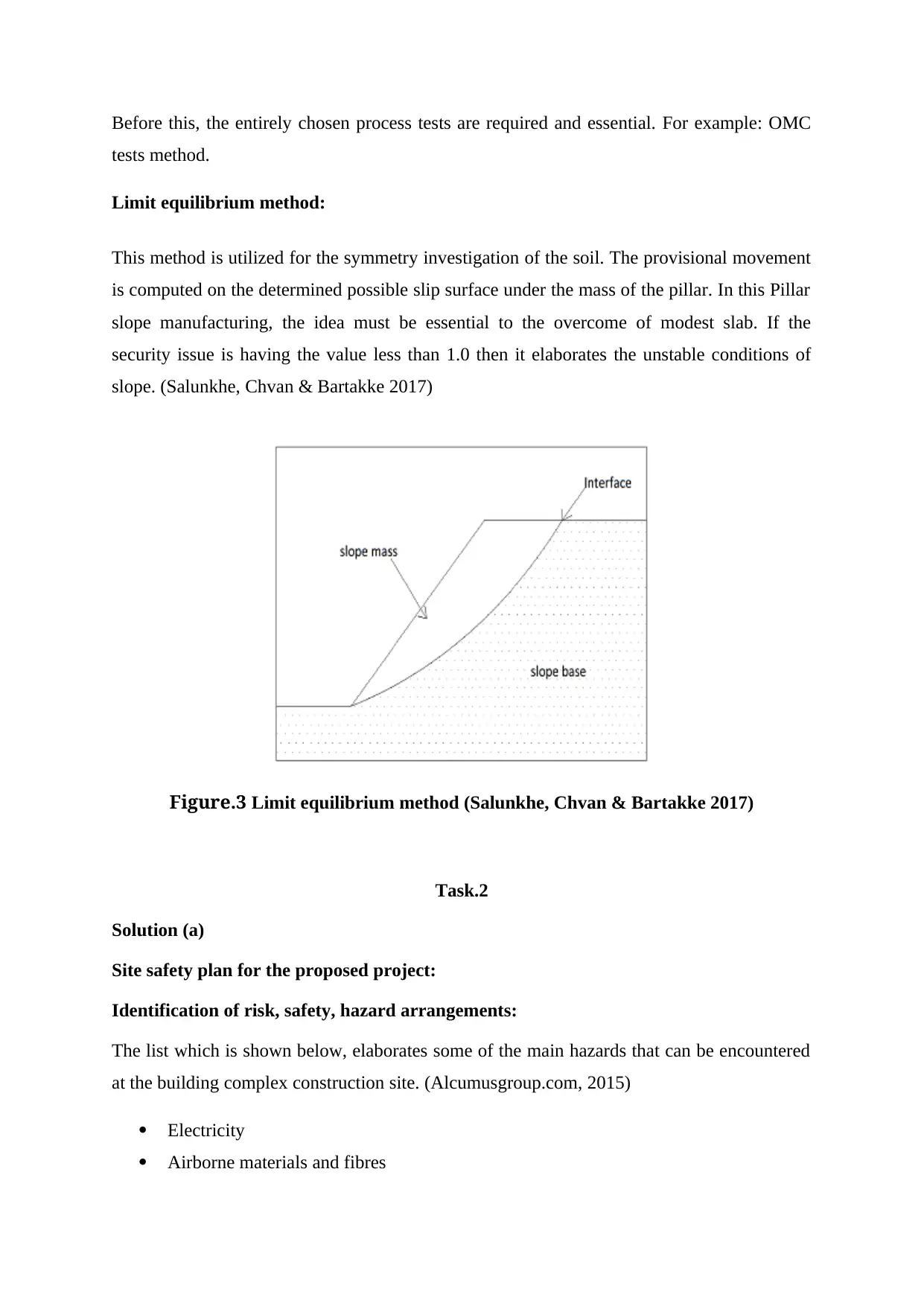
Before this, the entirely chosen process tests are required and essential. For example: OMC
tests method.
Limit equilibrium method:
This method is utilized for the symmetry investigation of the soil. The provisional movement
is computed on the determined possible slip surface under the mass of the pillar. In this Pillar
slope manufacturing, the idea must be essential to the overcome of modest slab. If the
security issue is having the value less than 1.0 then it elaborates the unstable conditions of
slope. (Salunkhe, Chvan & Bartakke 2017)
Figure.3 Limit equilibrium method (Salunkhe, Chvan & Bartakke 2017)
Task.2
Solution (a)
Site safety plan for the proposed project:
Identification of risk, safety, hazard arrangements:
The list which is shown below, elaborates some of the main hazards that can be encountered
at the building complex construction site. (Alcumusgroup.com, 2015)
Electricity
Airborne materials and fibres
tests method.
Limit equilibrium method:
This method is utilized for the symmetry investigation of the soil. The provisional movement
is computed on the determined possible slip surface under the mass of the pillar. In this Pillar
slope manufacturing, the idea must be essential to the overcome of modest slab. If the
security issue is having the value less than 1.0 then it elaborates the unstable conditions of
slope. (Salunkhe, Chvan & Bartakke 2017)
Figure.3 Limit equilibrium method (Salunkhe, Chvan & Bartakke 2017)
Task.2
Solution (a)
Site safety plan for the proposed project:
Identification of risk, safety, hazard arrangements:
The list which is shown below, elaborates some of the main hazards that can be encountered
at the building complex construction site. (Alcumusgroup.com, 2015)
Electricity
Airborne materials and fibres
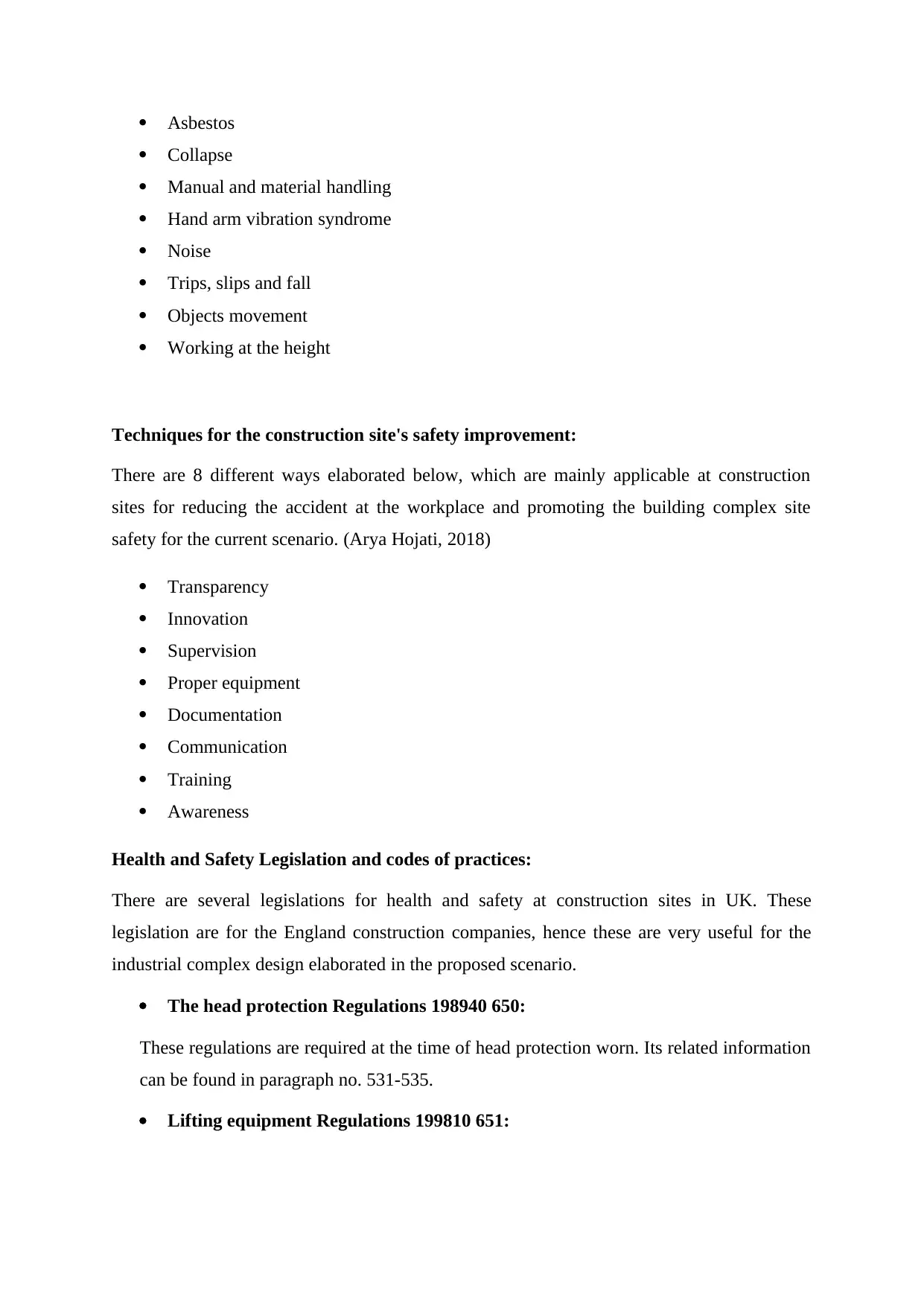
Asbestos
Collapse
Manual and material handling
Hand arm vibration syndrome
Noise
Trips, slips and fall
Objects movement
Working at the height
Techniques for the construction site's safety improvement:
There are 8 different ways elaborated below, which are mainly applicable at construction
sites for reducing the accident at the workplace and promoting the building complex site
safety for the current scenario. (Arya Hojati, 2018)
Transparency
Innovation
Supervision
Proper equipment
Documentation
Communication
Training
Awareness
Health and Safety Legislation and codes of practices:
There are several legislations for health and safety at construction sites in UK. These
legislation are for the England construction companies, hence these are very useful for the
industrial complex design elaborated in the proposed scenario.
The head protection Regulations 198940 650:
These regulations are required at the time of head protection worn. Its related information
can be found in paragraph no. 531-535.
Lifting equipment Regulations 199810 651:
Collapse
Manual and material handling
Hand arm vibration syndrome
Noise
Trips, slips and fall
Objects movement
Working at the height
Techniques for the construction site's safety improvement:
There are 8 different ways elaborated below, which are mainly applicable at construction
sites for reducing the accident at the workplace and promoting the building complex site
safety for the current scenario. (Arya Hojati, 2018)
Transparency
Innovation
Supervision
Proper equipment
Documentation
Communication
Training
Awareness
Health and Safety Legislation and codes of practices:
There are several legislations for health and safety at construction sites in UK. These
legislation are for the England construction companies, hence these are very useful for the
industrial complex design elaborated in the proposed scenario.
The head protection Regulations 198940 650:
These regulations are required at the time of head protection worn. Its related information
can be found in paragraph no. 531-535.
Lifting equipment Regulations 199810 651:
Paraphrase This Document
Need a fresh take? Get an instant paraphrase of this document with our AI Paraphraser
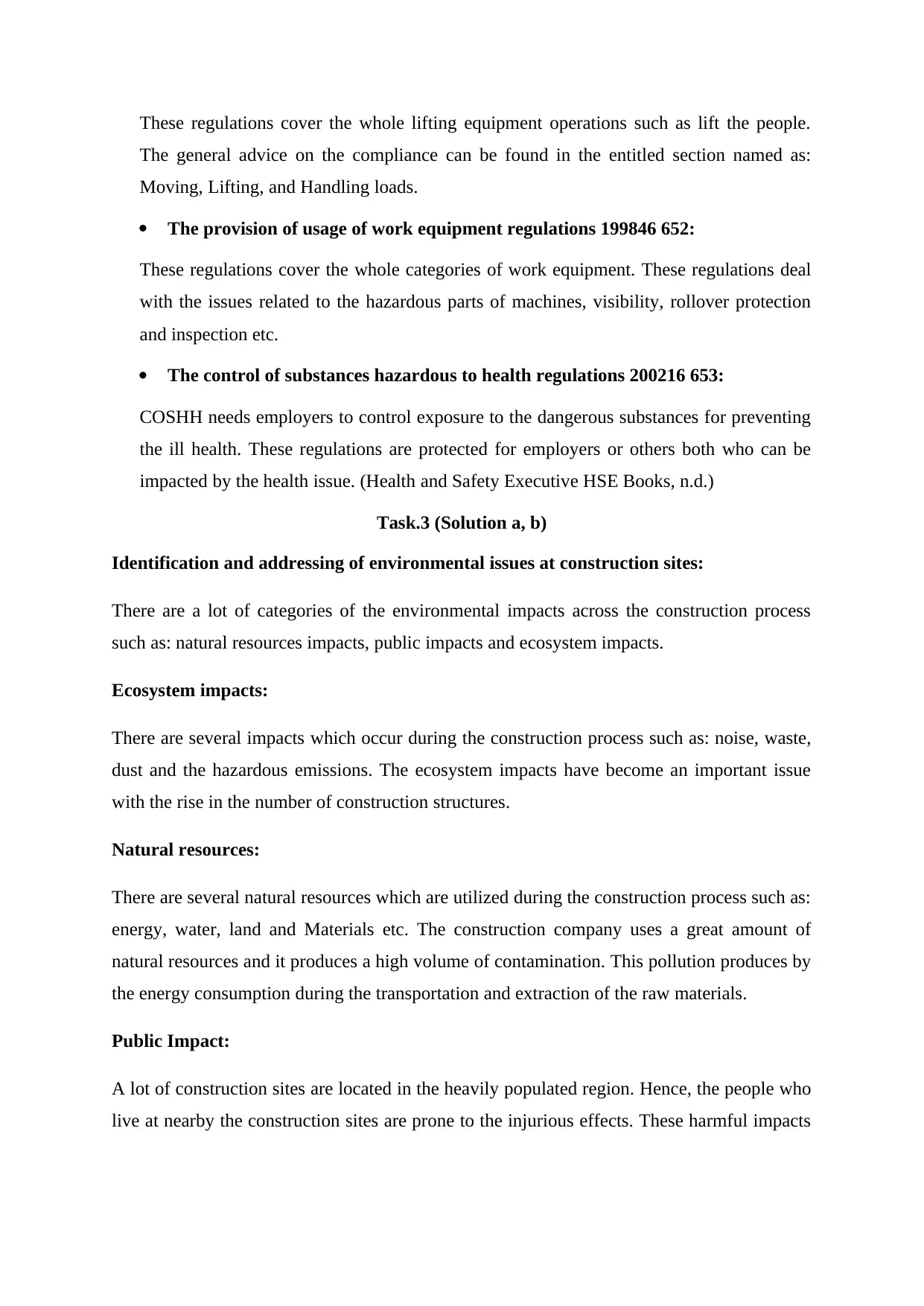
These regulations cover the whole lifting equipment operations such as lift the people.
The general advice on the compliance can be found in the entitled section named as:
Moving, Lifting, and Handling loads.
The provision of usage of work equipment regulations 199846 652:
These regulations cover the whole categories of work equipment. These regulations deal
with the issues related to the hazardous parts of machines, visibility, rollover protection
and inspection etc.
The control of substances hazardous to health regulations 200216 653:
COSHH needs employers to control exposure to the dangerous substances for preventing
the ill health. These regulations are protected for employers or others both who can be
impacted by the health issue. (Health and Safety Executive HSE Books, n.d.)
Task.3 (Solution a, b)
Identification and addressing of environmental issues at construction sites:
There are a lot of categories of the environmental impacts across the construction process
such as: natural resources impacts, public impacts and ecosystem impacts.
Ecosystem impacts:
There are several impacts which occur during the construction process such as: noise, waste,
dust and the hazardous emissions. The ecosystem impacts have become an important issue
with the rise in the number of construction structures.
Natural resources:
There are several natural resources which are utilized during the construction process such as:
energy, water, land and Materials etc. The construction company uses a great amount of
natural resources and it produces a high volume of contamination. This pollution produces by
the energy consumption during the transportation and extraction of the raw materials.
Public Impact:
A lot of construction sites are located in the heavily populated region. Hence, the people who
live at nearby the construction sites are prone to the injurious effects. These harmful impacts
The general advice on the compliance can be found in the entitled section named as:
Moving, Lifting, and Handling loads.
The provision of usage of work equipment regulations 199846 652:
These regulations cover the whole categories of work equipment. These regulations deal
with the issues related to the hazardous parts of machines, visibility, rollover protection
and inspection etc.
The control of substances hazardous to health regulations 200216 653:
COSHH needs employers to control exposure to the dangerous substances for preventing
the ill health. These regulations are protected for employers or others both who can be
impacted by the health issue. (Health and Safety Executive HSE Books, n.d.)
Task.3 (Solution a, b)
Identification and addressing of environmental issues at construction sites:
There are a lot of categories of the environmental impacts across the construction process
such as: natural resources impacts, public impacts and ecosystem impacts.
Ecosystem impacts:
There are several impacts which occur during the construction process such as: noise, waste,
dust and the hazardous emissions. The ecosystem impacts have become an important issue
with the rise in the number of construction structures.
Natural resources:
There are several natural resources which are utilized during the construction process such as:
energy, water, land and Materials etc. The construction company uses a great amount of
natural resources and it produces a high volume of contamination. This pollution produces by
the energy consumption during the transportation and extraction of the raw materials.
Public Impact:
A lot of construction sites are located in the heavily populated region. Hence, the people who
live at nearby the construction sites are prone to the injurious effects. These harmful impacts
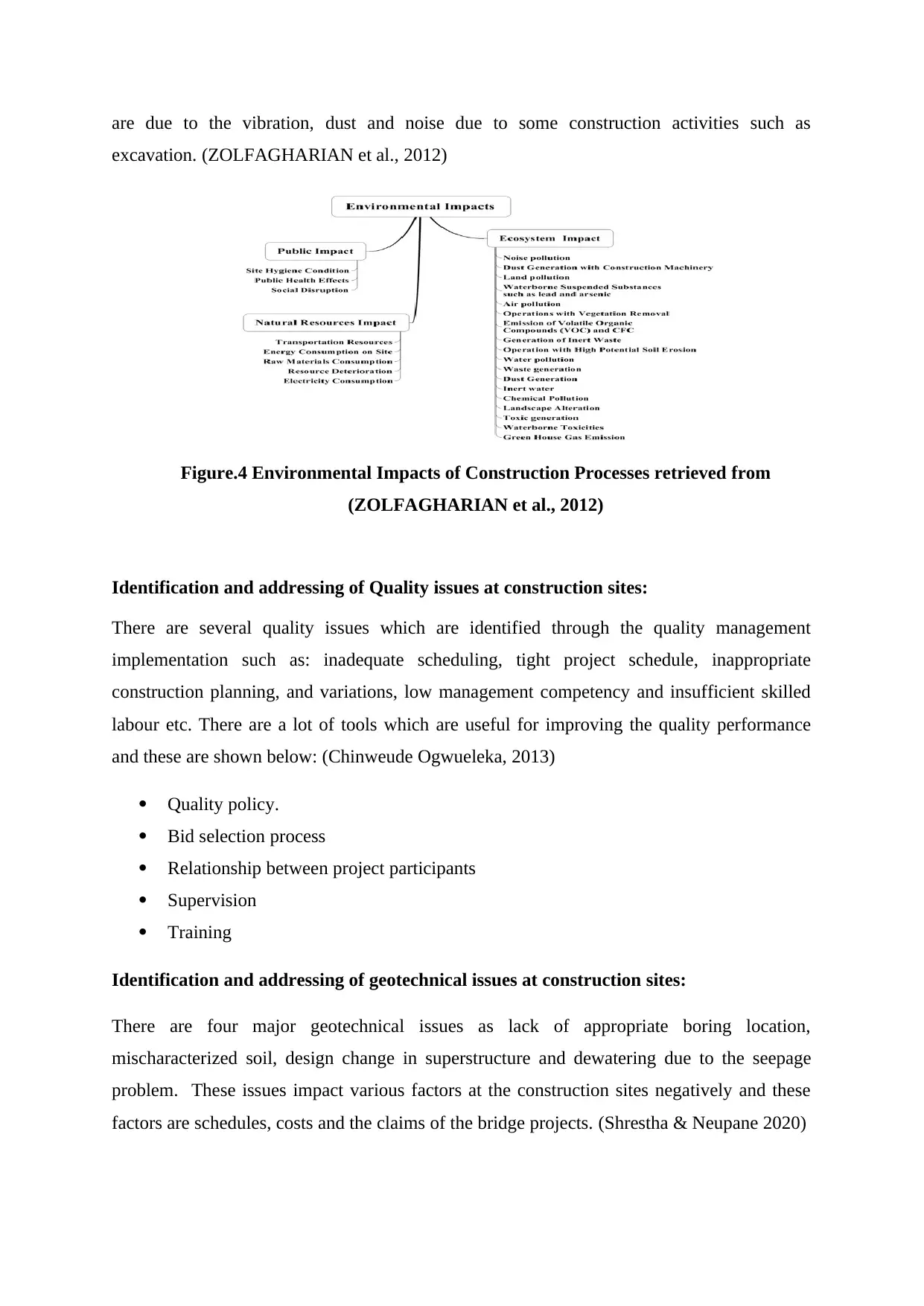
are due to the vibration, dust and noise due to some construction activities such as
excavation. (ZOLFAGHARIAN et al., 2012)
Figure.4 Environmental Impacts of Construction Processes retrieved from
(ZOLFAGHARIAN et al., 2012)
Identification and addressing of Quality issues at construction sites:
There are several quality issues which are identified through the quality management
implementation such as: inadequate scheduling, tight project schedule, inappropriate
construction planning, and variations, low management competency and insufficient skilled
labour etc. There are a lot of tools which are useful for improving the quality performance
and these are shown below: (Chinweude Ogwueleka, 2013)
Quality policy.
Bid selection process
Relationship between project participants
Supervision
Training
Identification and addressing of geotechnical issues at construction sites:
There are four major geotechnical issues as lack of appropriate boring location,
mischaracterized soil, design change in superstructure and dewatering due to the seepage
problem. These issues impact various factors at the construction sites negatively and these
factors are schedules, costs and the claims of the bridge projects. (Shrestha & Neupane 2020)
excavation. (ZOLFAGHARIAN et al., 2012)
Figure.4 Environmental Impacts of Construction Processes retrieved from
(ZOLFAGHARIAN et al., 2012)
Identification and addressing of Quality issues at construction sites:
There are several quality issues which are identified through the quality management
implementation such as: inadequate scheduling, tight project schedule, inappropriate
construction planning, and variations, low management competency and insufficient skilled
labour etc. There are a lot of tools which are useful for improving the quality performance
and these are shown below: (Chinweude Ogwueleka, 2013)
Quality policy.
Bid selection process
Relationship between project participants
Supervision
Training
Identification and addressing of geotechnical issues at construction sites:
There are four major geotechnical issues as lack of appropriate boring location,
mischaracterized soil, design change in superstructure and dewatering due to the seepage
problem. These issues impact various factors at the construction sites negatively and these
factors are schedules, costs and the claims of the bridge projects. (Shrestha & Neupane 2020)
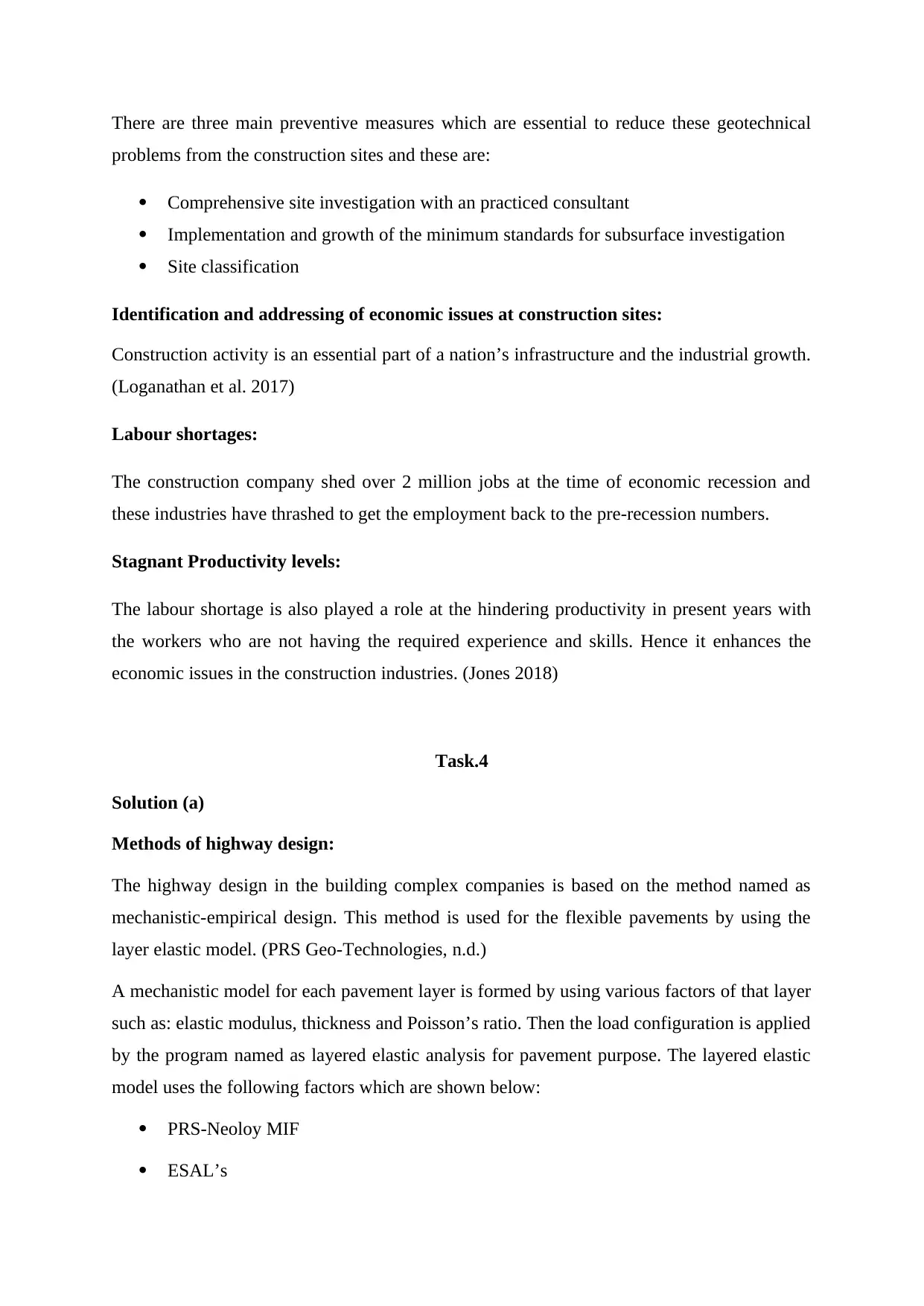
There are three main preventive measures which are essential to reduce these geotechnical
problems from the construction sites and these are:
Comprehensive site investigation with an practiced consultant
Implementation and growth of the minimum standards for subsurface investigation
Site classification
Identification and addressing of economic issues at construction sites:
Construction activity is an essential part of a nation’s infrastructure and the industrial growth.
(Loganathan et al. 2017)
Labour shortages:
The construction company shed over 2 million jobs at the time of economic recession and
these industries have thrashed to get the employment back to the pre-recession numbers.
Stagnant Productivity levels:
The labour shortage is also played a role at the hindering productivity in present years with
the workers who are not having the required experience and skills. Hence it enhances the
economic issues in the construction industries. (Jones 2018)
Task.4
Solution (a)
Methods of highway design:
The highway design in the building complex companies is based on the method named as
mechanistic-empirical design. This method is used for the flexible pavements by using the
layer elastic model. (PRS Geo-Technologies, n.d.)
A mechanistic model for each pavement layer is formed by using various factors of that layer
such as: elastic modulus, thickness and Poisson’s ratio. Then the load configuration is applied
by the program named as layered elastic analysis for pavement purpose. The layered elastic
model uses the following factors which are shown below:
PRS-Neoloy MIF
ESAL’s
problems from the construction sites and these are:
Comprehensive site investigation with an practiced consultant
Implementation and growth of the minimum standards for subsurface investigation
Site classification
Identification and addressing of economic issues at construction sites:
Construction activity is an essential part of a nation’s infrastructure and the industrial growth.
(Loganathan et al. 2017)
Labour shortages:
The construction company shed over 2 million jobs at the time of economic recession and
these industries have thrashed to get the employment back to the pre-recession numbers.
Stagnant Productivity levels:
The labour shortage is also played a role at the hindering productivity in present years with
the workers who are not having the required experience and skills. Hence it enhances the
economic issues in the construction industries. (Jones 2018)
Task.4
Solution (a)
Methods of highway design:
The highway design in the building complex companies is based on the method named as
mechanistic-empirical design. This method is used for the flexible pavements by using the
layer elastic model. (PRS Geo-Technologies, n.d.)
A mechanistic model for each pavement layer is formed by using various factors of that layer
such as: elastic modulus, thickness and Poisson’s ratio. Then the load configuration is applied
by the program named as layered elastic analysis for pavement purpose. The layered elastic
model uses the following factors which are shown below:
PRS-Neoloy MIF
ESAL’s
Secure Best Marks with AI Grader
Need help grading? Try our AI Grader for instant feedback on your assignments.
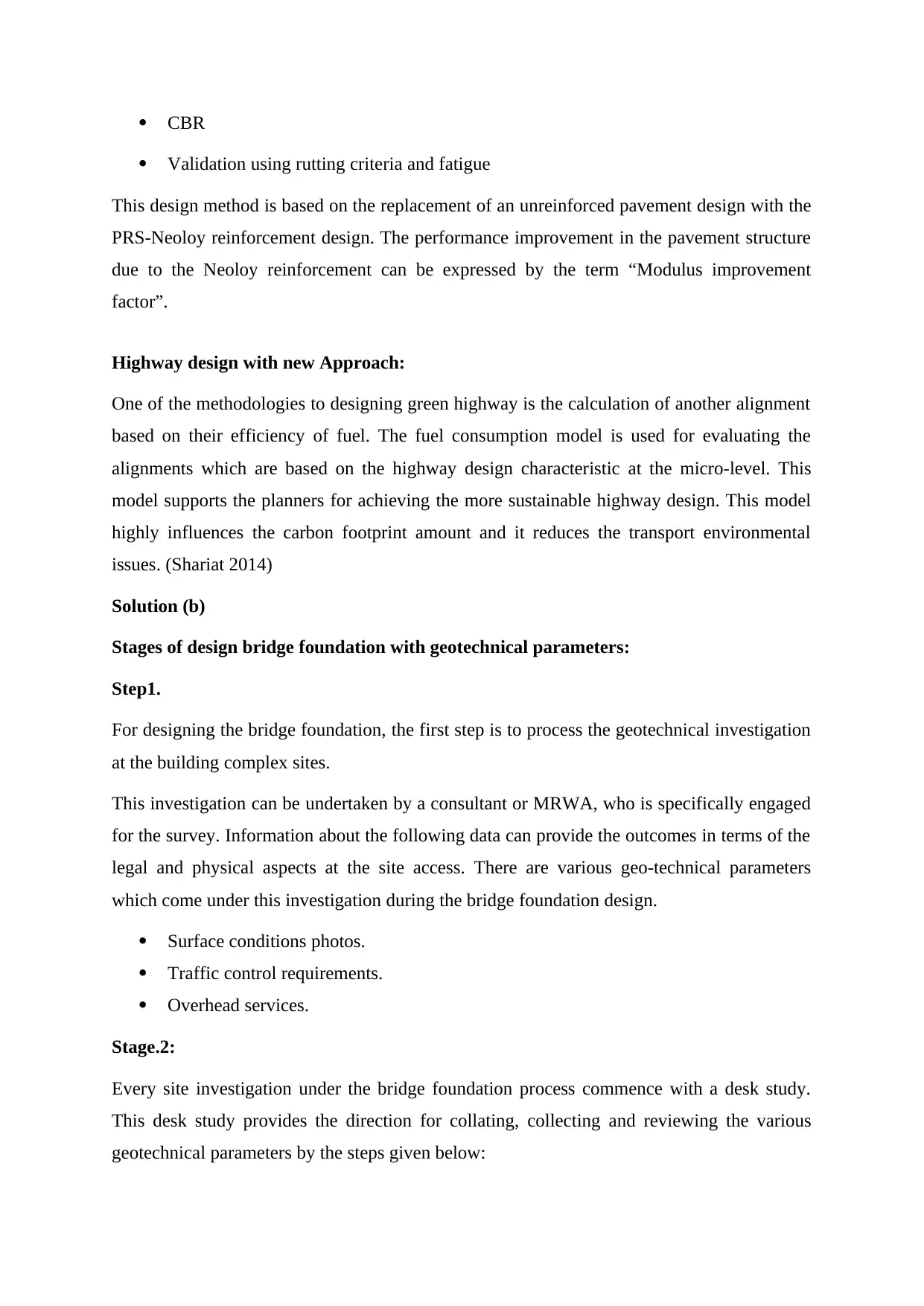
CBR
Validation using rutting criteria and fatigue
This design method is based on the replacement of an unreinforced pavement design with the
PRS-Neoloy reinforcement design. The performance improvement in the pavement structure
due to the Neoloy reinforcement can be expressed by the term “Modulus improvement
factor”.
Highway design with new Approach:
One of the methodologies to designing green highway is the calculation of another alignment
based on their efficiency of fuel. The fuel consumption model is used for evaluating the
alignments which are based on the highway design characteristic at the micro-level. This
model supports the planners for achieving the more sustainable highway design. This model
highly influences the carbon footprint amount and it reduces the transport environmental
issues. (Shariat 2014)
Solution (b)
Stages of design bridge foundation with geotechnical parameters:
Step1.
For designing the bridge foundation, the first step is to process the geotechnical investigation
at the building complex sites.
This investigation can be undertaken by a consultant or MRWA, who is specifically engaged
for the survey. Information about the following data can provide the outcomes in terms of the
legal and physical aspects at the site access. There are various geo-technical parameters
which come under this investigation during the bridge foundation design.
Surface conditions photos.
Traffic control requirements.
Overhead services.
Stage.2:
Every site investigation under the bridge foundation process commence with a desk study.
This desk study provides the direction for collating, collecting and reviewing the various
geotechnical parameters by the steps given below:
Validation using rutting criteria and fatigue
This design method is based on the replacement of an unreinforced pavement design with the
PRS-Neoloy reinforcement design. The performance improvement in the pavement structure
due to the Neoloy reinforcement can be expressed by the term “Modulus improvement
factor”.
Highway design with new Approach:
One of the methodologies to designing green highway is the calculation of another alignment
based on their efficiency of fuel. The fuel consumption model is used for evaluating the
alignments which are based on the highway design characteristic at the micro-level. This
model supports the planners for achieving the more sustainable highway design. This model
highly influences the carbon footprint amount and it reduces the transport environmental
issues. (Shariat 2014)
Solution (b)
Stages of design bridge foundation with geotechnical parameters:
Step1.
For designing the bridge foundation, the first step is to process the geotechnical investigation
at the building complex sites.
This investigation can be undertaken by a consultant or MRWA, who is specifically engaged
for the survey. Information about the following data can provide the outcomes in terms of the
legal and physical aspects at the site access. There are various geo-technical parameters
which come under this investigation during the bridge foundation design.
Surface conditions photos.
Traffic control requirements.
Overhead services.
Stage.2:
Every site investigation under the bridge foundation process commence with a desk study.
This desk study provides the direction for collating, collecting and reviewing the various
geotechnical parameters by the steps given below:
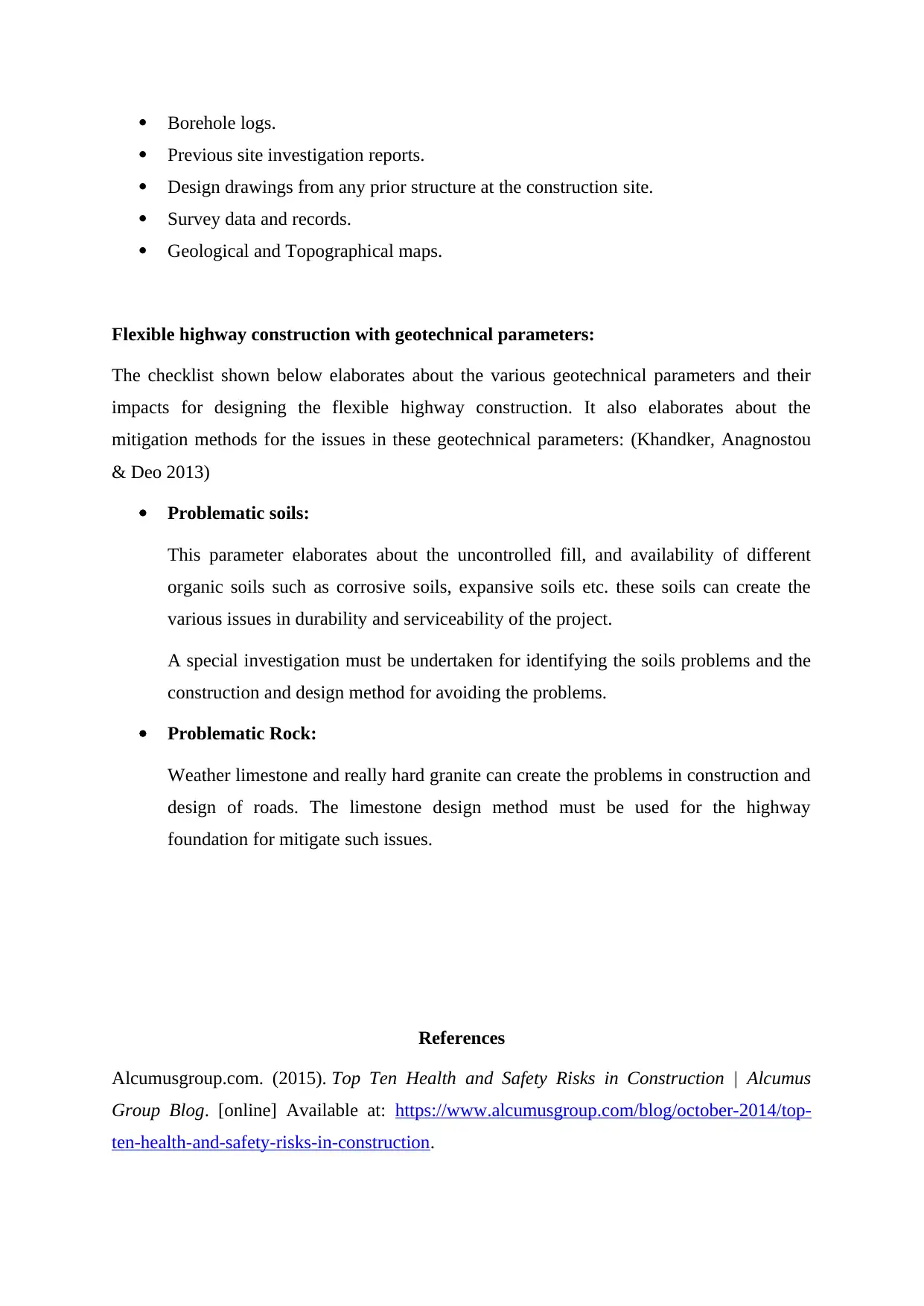
Borehole logs.
Previous site investigation reports.
Design drawings from any prior structure at the construction site.
Survey data and records.
Geological and Topographical maps.
Flexible highway construction with geotechnical parameters:
The checklist shown below elaborates about the various geotechnical parameters and their
impacts for designing the flexible highway construction. It also elaborates about the
mitigation methods for the issues in these geotechnical parameters: (Khandker, Anagnostou
& Deo 2013)
Problematic soils:
This parameter elaborates about the uncontrolled fill, and availability of different
organic soils such as corrosive soils, expansive soils etc. these soils can create the
various issues in durability and serviceability of the project.
A special investigation must be undertaken for identifying the soils problems and the
construction and design method for avoiding the problems.
Problematic Rock:
Weather limestone and really hard granite can create the problems in construction and
design of roads. The limestone design method must be used for the highway
foundation for mitigate such issues.
References
Alcumusgroup.com. (2015). Top Ten Health and Safety Risks in Construction | Alcumus
Group Blog. [online] Available at: https://www.alcumusgroup.com/blog/october-2014/top-
ten-health-and-safety-risks-in-construction.
Previous site investigation reports.
Design drawings from any prior structure at the construction site.
Survey data and records.
Geological and Topographical maps.
Flexible highway construction with geotechnical parameters:
The checklist shown below elaborates about the various geotechnical parameters and their
impacts for designing the flexible highway construction. It also elaborates about the
mitigation methods for the issues in these geotechnical parameters: (Khandker, Anagnostou
& Deo 2013)
Problematic soils:
This parameter elaborates about the uncontrolled fill, and availability of different
organic soils such as corrosive soils, expansive soils etc. these soils can create the
various issues in durability and serviceability of the project.
A special investigation must be undertaken for identifying the soils problems and the
construction and design method for avoiding the problems.
Problematic Rock:
Weather limestone and really hard granite can create the problems in construction and
design of roads. The limestone design method must be used for the highway
foundation for mitigate such issues.
References
Alcumusgroup.com. (2015). Top Ten Health and Safety Risks in Construction | Alcumus
Group Blog. [online] Available at: https://www.alcumusgroup.com/blog/october-2014/top-
ten-health-and-safety-risks-in-construction.
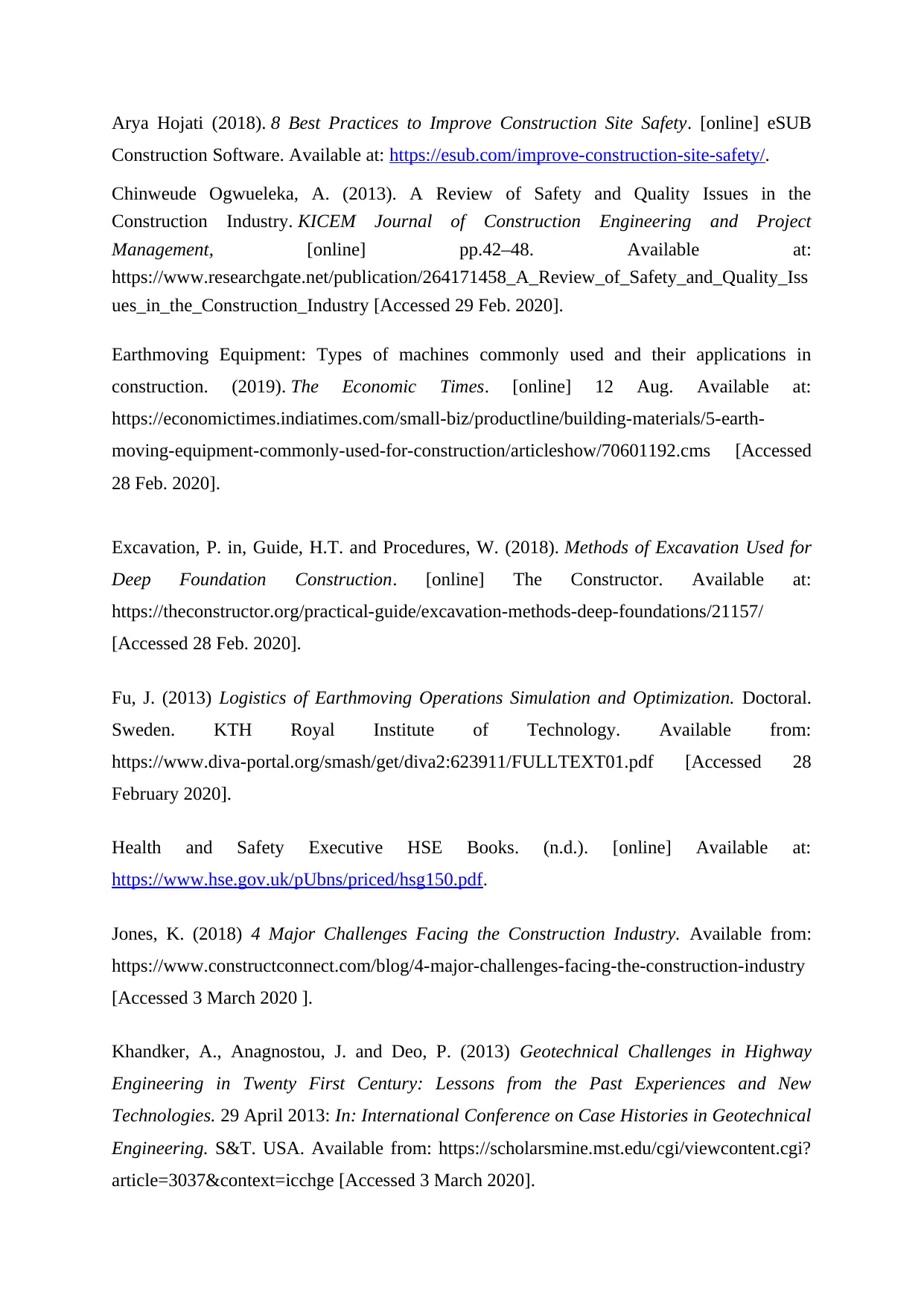
Arya Hojati (2018). 8 Best Practices to Improve Construction Site Safety. [online] eSUB
Construction Software. Available at: https://esub.com/improve-construction-site-safety/.
Chinweude Ogwueleka, A. (2013). A Review of Safety and Quality Issues in the
Construction Industry. KICEM Journal of Construction Engineering and Project
Management, [online] pp.42–48. Available at:
https://www.researchgate.net/publication/264171458_A_Review_of_Safety_and_Quality_Iss
ues_in_the_Construction_Industry [Accessed 29 Feb. 2020].
Earthmoving Equipment: Types of machines commonly used and their applications in
construction. (2019). The Economic Times. [online] 12 Aug. Available at:
https://economictimes.indiatimes.com/small-biz/productline/building-materials/5-earth-
moving-equipment-commonly-used-for-construction/articleshow/70601192.cms [Accessed
28 Feb. 2020].
Excavation, P. in, Guide, H.T. and Procedures, W. (2018). Methods of Excavation Used for
Deep Foundation Construction. [online] The Constructor. Available at:
https://theconstructor.org/practical-guide/excavation-methods-deep-foundations/21157/
[Accessed 28 Feb. 2020].
Fu, J. (2013) Logistics of Earthmoving Operations Simulation and Optimization. Doctoral.
Sweden. KTH Royal Institute of Technology. Available from:
https://www.diva-portal.org/smash/get/diva2:623911/FULLTEXT01.pdf [Accessed 28
February 2020].
Health and Safety Executive HSE Books. (n.d.). [online] Available at:
https://www.hse.gov.uk/pUbns/priced/hsg150.pdf.
Jones, K. (2018) 4 Major Challenges Facing the Construction Industry. Available from:
https://www.constructconnect.com/blog/4-major-challenges-facing-the-construction-industry
[Accessed 3 March 2020 ].
Khandker, A., Anagnostou, J. and Deo, P. (2013) Geotechnical Challenges in Highway
Engineering in Twenty First Century: Lessons from the Past Experiences and New
Technologies. 29 April 2013: In: International Conference on Case Histories in Geotechnical
Engineering. S&T. USA. Available from: https://scholarsmine.mst.edu/cgi/viewcontent.cgi?
article=3037&context=icchge [Accessed 3 March 2020].
Construction Software. Available at: https://esub.com/improve-construction-site-safety/.
Chinweude Ogwueleka, A. (2013). A Review of Safety and Quality Issues in the
Construction Industry. KICEM Journal of Construction Engineering and Project
Management, [online] pp.42–48. Available at:
https://www.researchgate.net/publication/264171458_A_Review_of_Safety_and_Quality_Iss
ues_in_the_Construction_Industry [Accessed 29 Feb. 2020].
Earthmoving Equipment: Types of machines commonly used and their applications in
construction. (2019). The Economic Times. [online] 12 Aug. Available at:
https://economictimes.indiatimes.com/small-biz/productline/building-materials/5-earth-
moving-equipment-commonly-used-for-construction/articleshow/70601192.cms [Accessed
28 Feb. 2020].
Excavation, P. in, Guide, H.T. and Procedures, W. (2018). Methods of Excavation Used for
Deep Foundation Construction. [online] The Constructor. Available at:
https://theconstructor.org/practical-guide/excavation-methods-deep-foundations/21157/
[Accessed 28 Feb. 2020].
Fu, J. (2013) Logistics of Earthmoving Operations Simulation and Optimization. Doctoral.
Sweden. KTH Royal Institute of Technology. Available from:
https://www.diva-portal.org/smash/get/diva2:623911/FULLTEXT01.pdf [Accessed 28
February 2020].
Health and Safety Executive HSE Books. (n.d.). [online] Available at:
https://www.hse.gov.uk/pUbns/priced/hsg150.pdf.
Jones, K. (2018) 4 Major Challenges Facing the Construction Industry. Available from:
https://www.constructconnect.com/blog/4-major-challenges-facing-the-construction-industry
[Accessed 3 March 2020 ].
Khandker, A., Anagnostou, J. and Deo, P. (2013) Geotechnical Challenges in Highway
Engineering in Twenty First Century: Lessons from the Past Experiences and New
Technologies. 29 April 2013: In: International Conference on Case Histories in Geotechnical
Engineering. S&T. USA. Available from: https://scholarsmine.mst.edu/cgi/viewcontent.cgi?
article=3037&context=icchge [Accessed 3 March 2020].
Paraphrase This Document
Need a fresh take? Get an instant paraphrase of this document with our AI Paraphraser
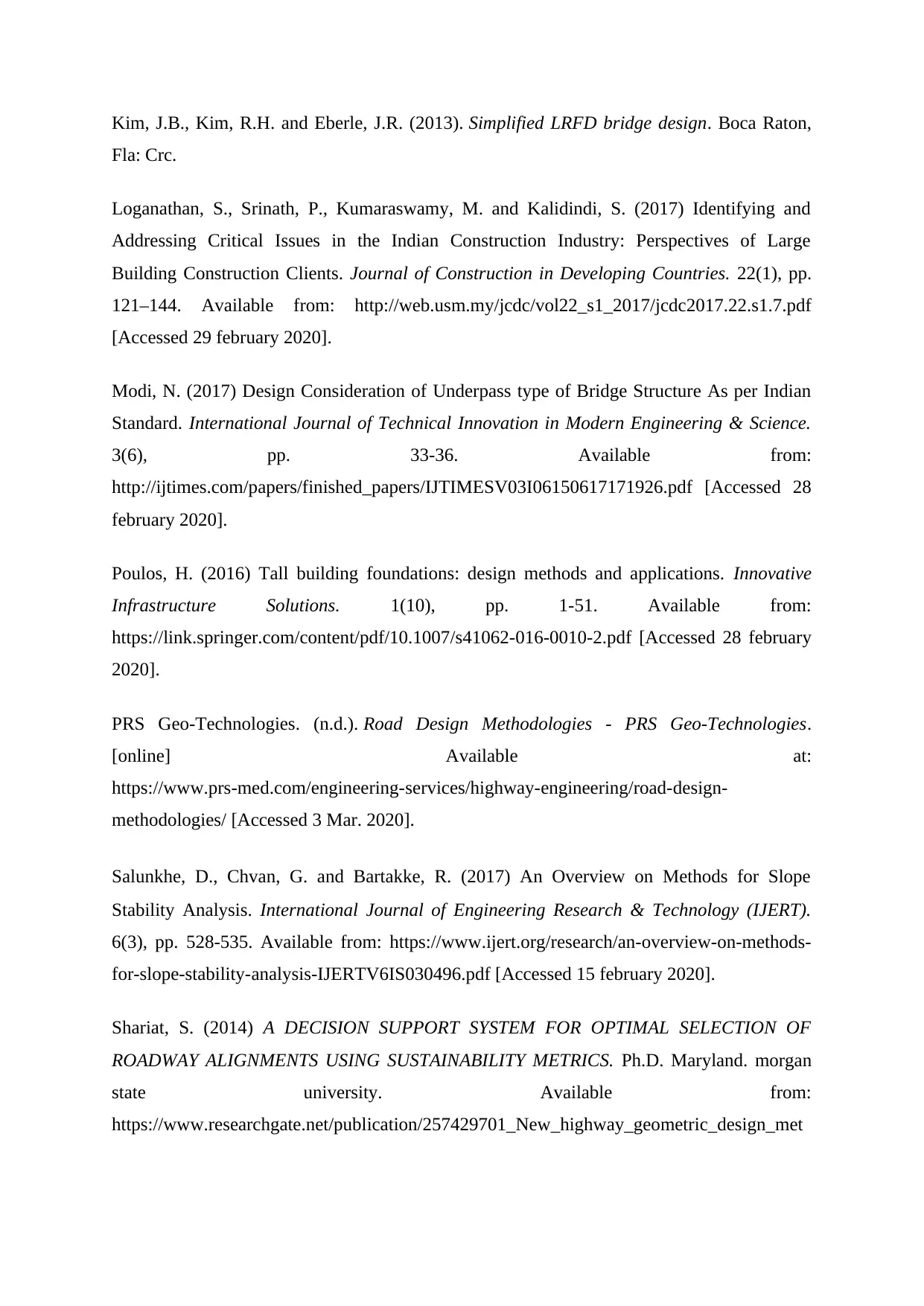
Kim, J.B., Kim, R.H. and Eberle, J.R. (2013). Simplified LRFD bridge design. Boca Raton,
Fla: Crc.
Loganathan, S., Srinath, P., Kumaraswamy, M. and Kalidindi, S. (2017) Identifying and
Addressing Critical Issues in the Indian Construction Industry: Perspectives of Large
Building Construction Clients. Journal of Construction in Developing Countries. 22(1), pp.
121–144. Available from: http://web.usm.my/jcdc/vol22_s1_2017/jcdc2017.22.s1.7.pdf
[Accessed 29 february 2020].
Modi, N. (2017) Design Consideration of Underpass type of Bridge Structure As per Indian
Standard. International Journal of Technical Innovation in Modern Engineering & Science.
3(6), pp. 33-36. Available from:
http://ijtimes.com/papers/finished_papers/IJTIMESV03I06150617171926.pdf [Accessed 28
february 2020].
Poulos, H. (2016) Tall building foundations: design methods and applications. Innovative
Infrastructure Solutions. 1(10), pp. 1-51. Available from:
https://link.springer.com/content/pdf/10.1007/s41062-016-0010-2.pdf [Accessed 28 february
2020].
PRS Geo-Technologies. (n.d.). Road Design Methodologies - PRS Geo-Technologies.
[online] Available at:
https://www.prs-med.com/engineering-services/highway-engineering/road-design-
methodologies/ [Accessed 3 Mar. 2020].
Salunkhe, D., Chvan, G. and Bartakke, R. (2017) An Overview on Methods for Slope
Stability Analysis. International Journal of Engineering Research & Technology (IJERT).
6(3), pp. 528-535. Available from: https://www.ijert.org/research/an-overview-on-methods-
for-slope-stability-analysis-IJERTV6IS030496.pdf [Accessed 15 february 2020].
Shariat, S. (2014) A DECISION SUPPORT SYSTEM FOR OPTIMAL SELECTION OF
ROADWAY ALIGNMENTS USING SUSTAINABILITY METRICS. Ph.D. Maryland. morgan
state university. Available from:
https://www.researchgate.net/publication/257429701_New_highway_geometric_design_met
Fla: Crc.
Loganathan, S., Srinath, P., Kumaraswamy, M. and Kalidindi, S. (2017) Identifying and
Addressing Critical Issues in the Indian Construction Industry: Perspectives of Large
Building Construction Clients. Journal of Construction in Developing Countries. 22(1), pp.
121–144. Available from: http://web.usm.my/jcdc/vol22_s1_2017/jcdc2017.22.s1.7.pdf
[Accessed 29 february 2020].
Modi, N. (2017) Design Consideration of Underpass type of Bridge Structure As per Indian
Standard. International Journal of Technical Innovation in Modern Engineering & Science.
3(6), pp. 33-36. Available from:
http://ijtimes.com/papers/finished_papers/IJTIMESV03I06150617171926.pdf [Accessed 28
february 2020].
Poulos, H. (2016) Tall building foundations: design methods and applications. Innovative
Infrastructure Solutions. 1(10), pp. 1-51. Available from:
https://link.springer.com/content/pdf/10.1007/s41062-016-0010-2.pdf [Accessed 28 february
2020].
PRS Geo-Technologies. (n.d.). Road Design Methodologies - PRS Geo-Technologies.
[online] Available at:
https://www.prs-med.com/engineering-services/highway-engineering/road-design-
methodologies/ [Accessed 3 Mar. 2020].
Salunkhe, D., Chvan, G. and Bartakke, R. (2017) An Overview on Methods for Slope
Stability Analysis. International Journal of Engineering Research & Technology (IJERT).
6(3), pp. 528-535. Available from: https://www.ijert.org/research/an-overview-on-methods-
for-slope-stability-analysis-IJERTV6IS030496.pdf [Accessed 15 february 2020].
Shariat, S. (2014) A DECISION SUPPORT SYSTEM FOR OPTIMAL SELECTION OF
ROADWAY ALIGNMENTS USING SUSTAINABILITY METRICS. Ph.D. Maryland. morgan
state university. Available from:
https://www.researchgate.net/publication/257429701_New_highway_geometric_design_met
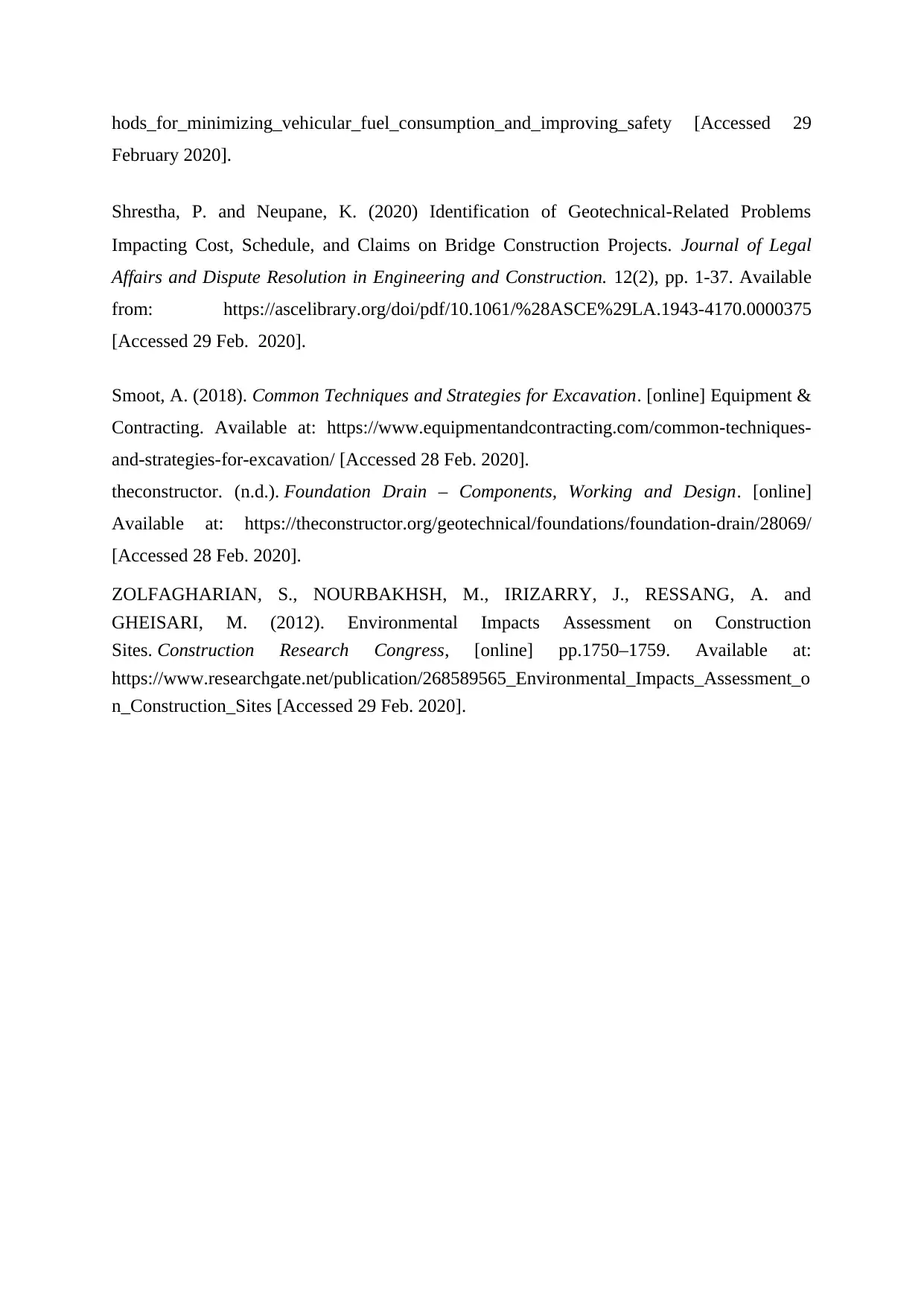
hods_for_minimizing_vehicular_fuel_consumption_and_improving_safety [Accessed 29
February 2020].
Shrestha, P. and Neupane, K. (2020) Identification of Geotechnical-Related Problems
Impacting Cost, Schedule, and Claims on Bridge Construction Projects. Journal of Legal
Affairs and Dispute Resolution in Engineering and Construction. 12(2), pp. 1-37. Available
from: https://ascelibrary.org/doi/pdf/10.1061/%28ASCE%29LA.1943-4170.0000375
[Accessed 29 Feb. 2020].
Smoot, A. (2018). Common Techniques and Strategies for Excavation. [online] Equipment &
Contracting. Available at: https://www.equipmentandcontracting.com/common-techniques-
and-strategies-for-excavation/ [Accessed 28 Feb. 2020].
theconstructor. (n.d.). Foundation Drain – Components, Working and Design. [online]
Available at: https://theconstructor.org/geotechnical/foundations/foundation-drain/28069/
[Accessed 28 Feb. 2020].
ZOLFAGHARIAN, S., NOURBAKHSH, M., IRIZARRY, J., RESSANG, A. and
GHEISARI, M. (2012). Environmental Impacts Assessment on Construction
Sites. Construction Research Congress, [online] pp.1750–1759. Available at:
https://www.researchgate.net/publication/268589565_Environmental_Impacts_Assessment_o
n_Construction_Sites [Accessed 29 Feb. 2020].
February 2020].
Shrestha, P. and Neupane, K. (2020) Identification of Geotechnical-Related Problems
Impacting Cost, Schedule, and Claims on Bridge Construction Projects. Journal of Legal
Affairs and Dispute Resolution in Engineering and Construction. 12(2), pp. 1-37. Available
from: https://ascelibrary.org/doi/pdf/10.1061/%28ASCE%29LA.1943-4170.0000375
[Accessed 29 Feb. 2020].
Smoot, A. (2018). Common Techniques and Strategies for Excavation. [online] Equipment &
Contracting. Available at: https://www.equipmentandcontracting.com/common-techniques-
and-strategies-for-excavation/ [Accessed 28 Feb. 2020].
theconstructor. (n.d.). Foundation Drain – Components, Working and Design. [online]
Available at: https://theconstructor.org/geotechnical/foundations/foundation-drain/28069/
[Accessed 28 Feb. 2020].
ZOLFAGHARIAN, S., NOURBAKHSH, M., IRIZARRY, J., RESSANG, A. and
GHEISARI, M. (2012). Environmental Impacts Assessment on Construction
Sites. Construction Research Congress, [online] pp.1750–1759. Available at:
https://www.researchgate.net/publication/268589565_Environmental_Impacts_Assessment_o
n_Construction_Sites [Accessed 29 Feb. 2020].

1 out of 16
Related Documents
Your All-in-One AI-Powered Toolkit for Academic Success.
+13062052269
info@desklib.com
Available 24*7 on WhatsApp / Email
![[object Object]](/_next/static/media/star-bottom.7253800d.svg)
Unlock your academic potential
© 2024 | Zucol Services PVT LTD | All rights reserved.





